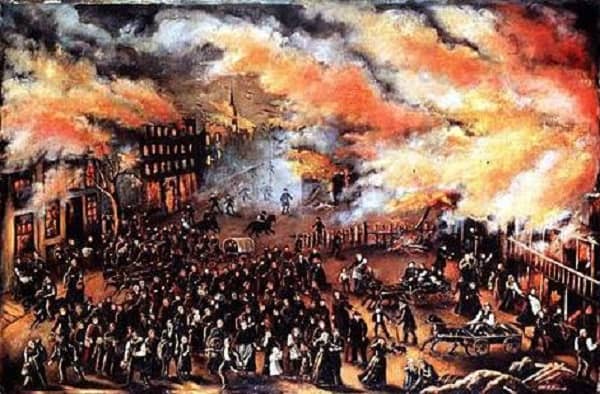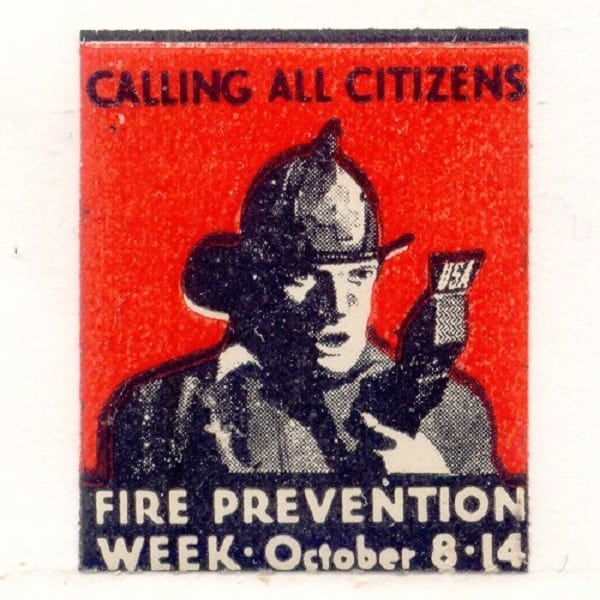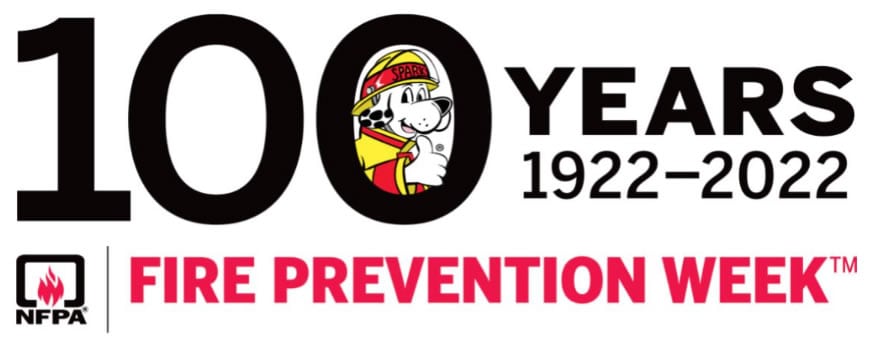NFPA’s annual event educates the public about fire safety
2022 marks the 100th anniversary of Fire Prevention Week, occurring October 9th through 15th. This annual event, sponsored by the National Fire Protection Association (NFPA), aims to save lives by educating people about fire dangers and how they can stay safe.
Here at QRFS, we’re used to thinking of NFPA in the context of fire protection codes, standards, systems, and engineering. But the organization’s Fire Prevention Week is explicitly about mass education. And it can significantly impact saving lives and property because many fires and associated deaths or injuries are preventable with a bit of knowledge.
Let’s dive into the history of Fire Prevention Week and how public safety has improved in the last century.
QRFS provides the residential and commercial fire protection equipment you need to stay safe and up to code. Be sure to check out more articles on our blog for information on fire safety, codes and standards, fire protection systems, and more.
The history of Fire Prevention Week
NFPA, whose mission is to reduce “death, injury, property, and economic loss due to fire, electrical and related hazards,” first sponsored Fire Prevention Week in 1922.
The dates of Fire Prevention Week every year correlate with and commemorate the infamous Great Chicago Fire, which started on October 8th, 1871. That massive blaze burned for three days, killing more than 250 people, leaving over 100,000 others homeless, destroying 17,400 structures, and burning over 2,000 acres of land.

President Calvin Coolidge declared Fire Prevention Week a national observance in 1925 in response to what he called “the nation’s enormous wastage, alike in human life and in property” due to preventable fires. In his proclamation, he said:
I am informed that during 1924 fires caused the loss of approximately 15,000 lives, and of property exceeding $548,000,000 in value. […] This waste results from conditions which justify a sense of shame and horror; for the greater part of it could and ought to be prevented.
For Coolidge, fire safety was a matter of national pride. He lamented that America’s fire situation was getting worse—losses from the first half of 1925 exceeded all of 1924—while in Europe, matters were improving. He noted that American fire losses per capita were five times Great Britain’s.
By making Fire Prevention Week a national observance, Coolidge hoped to stop senseless waste and catch America up to the rest of the world. And NFPA has been doing just that over the last century, serving as the leading source of fire protection and safety information.
Fire Prevention Week across the years
In 2022, the theme of Fire Prevention Week is “Fire Won’t Wait, Plan Your Escape.” And across the years, a wide variety of different themes and slogans have been used to motivate safety. The Guildford, Connecticut Fire Department lists most of them; many are snapshots of American history.
The early days of the observance emphasized the waste that so distressed President Coolidge. “Why This Mad Sacrifice to Fire?” was the slogan in 1927, for example. In 1930, it was “Fight Fire Waste with Fire Prevention. Do Your Part.”

During World War II, the slogans emphasized how fires hurt the war effort on the home front. Some examples include:
- “Today Every Fire Helps Hitler” (1942)
- “Fires Fight for the Axis” (1943)
- “Feed Fighters not Fires” (1943 and 1944, for farm safety)
- “The War’s Over for This Plant” (1943, for industrial safety)
- “We Burned the Enemy—Now Save Yourself from Fire” (1945)
In the postwar decade, NFPA aimed much of the message at young families thinking about the future:
- “Flameproof Your Future” (1949)
- “Be Free of Fear from Fire” (1952)
- “Let’s Grow Up—Not Burn Up” (1954)
- “Make Sure of their Tomorrows—Don’t Give Fire a Place to Start” (1957)
And in subsequent decades, the slogans focused on specific behaviors NFPA wanted to encourage:
- “Fire Drills Save Lives at Home, at School, at Work” (1985)
- “A Sound You Can Live With: Test Your Smoke Detector” (1988)
- “Big Fires Start Small: Keep Matches and Lighters in the Right Hands” (1989)
- “Get Out, Stay Out: Your Fire Safe Response” (1993)
- “Use Candles with Care” (2005)
- “Prevent Cooking Fires: Watch What You Heat” (2006)
Every year, Fire Prevention Week switches up the slogan and theme. But all years have the same goal: increased fire safety through public education.
Fire safety statistics show dramatic improvement over the years
Has Fire Prevention Week been successful? It’s impossible to quantify the exact effect of a national awareness event, but fire protection and prevention knowledge play a significant role.
The US Fire Administration, NFPA, and other entities collect and publish historical data on the number of fires, fire deaths, injuries, and the economic damage caused by fires. Overall, these numbers tell a very positive story: fires, fire-related deaths and injuries, and fire damage have vastly decreased over decades.
Here are some key numbers from NFPA’s 2017 report, “Trends and Patterns of U.S. Fire Loss:”
- Between 1977 and 2015, reported fires fell 59%, from 3,264,500 to 1,345,000.
- The decline was even greater as a percentage of the population: “the rate of reported fires per 1,000 population fell 72% from 14.8 in 1977 to 4.2 in 2015.”
- The overall fire death rate (all structures) fell from 34.4 deaths per million people in 1977 to 10.2 per million in 2015.
- Adjusted for inflation, direct property damage from fires dropped 22% — from $18.4 billion in 1977 to $14.3 billion in 2015.
NFPA’s 2021 report, “Fire Safety in the United States since 1980,” focused on residential fires. It showed that between 1980 and 2018:
- The number of reported home fires, including those in single-family homes, duplexes, and apartments, decreased by nearly half (from 734,000 to 363,000).
- The annual number of deaths decreased by 48% (5,200 vs. 2,720).
- Annual home-fire-related injuries declined by 43% (19,700 vs. 11,200).
- Residential property losses declined far less dramatically but still lessened by 8% (from $8.7 billion to $8 billion in inflation-adjusted dollars).
According to NFPA’s 2021 report on Home Structure Fires, the top three causes of home fires studied over five years were cooking (49%), heating equipment (13%), and electrical distribution and lighting equipment (9%). The biggest causes of fire deaths were smoking materials (23%), cooking (20%), and heating equipment (18%).

Unfortunately, there is one big caveat to the otherwise massive improvement in US fire statistics (emphasis added): “the death rate per 1,000 reported home fires has remained fairly consistent” between 1980 and 2018 and has even slightly exceeded earlier averages in recent years. For example, the death rate was 7.1 deaths per 1,000 home fires in 1980 and 7.5 deaths per thousand home fires in 2018. Analysts report that modern construction materials and furnishings that burn hotter and faster play a role in this unfortunately stagnant statistic.
Nevertheless, fire safety has improved dramatically in the past four decades — and even more compared to the earliest days of Fire Prevention Week. Recall that President Coolidge cited approximately 15,000 lives lost in 1924 when the US population totaled only 114 million people. In comparison, the US experienced 3,348 (civilian and firefighter) fire-related deaths in 2015, with a population of over 320 million.
This Fire Prevention Week spread the word on safety
For 100 years, NFPA has been encouraging fire safety by sponsoring National Fire Prevention Week. And while the organization’s broader efforts include publishing model codes, standards, and research, ensuring governmental responsibility, improving code compliance, and more, Fire Prevention Week exclusively focuses on what everyday people can do to prevent fires or stay safe in an emergency. An “informed public” is one of eight pillars in NFPA’s “Fire & Life Safety Ecosystem” that work together to improve public safety.
US fire safety has drastically improved in the last century, with the positive statistics shaped by fire protection technology, evolving codes and best practices, and public awareness. But there is still plenty of room for improvement. So, be sure to do your part—check out this year’s Fire Prevention Week resources and spread the word!
QRFS is your partner in fire protection. Check out our extensive catalog of equipment, tools, and accessories, and bookmark our blog to learn more about fire protection systems, devices, codes, and more.
Call us at +1 (888) 361-6662 or email support@qrfs.com with any questions.
This blog was originally posted at QRFS.com/blog. If this article helped you, check us out at Facebook.com/QuickResponseFireSupply or on Twitter @QuickResponseFS.


